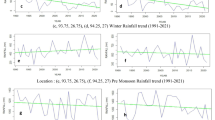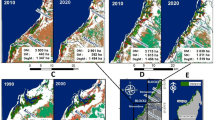Abstract
Using the methods of combining landscape ecology with GIS spatial analysis, this paper analyses the dynamics of the marsh landscape structure of the Sanjiang Plain in the past 20 years, furthermore, taking Fujin County, located in the north of the plain, as an example, analyzes the conversion between marsh and other land use types. It is shown that the marsh in the Sanjiang Plain decreased greatly in the past 20 years, but the trend has begun to reverse. The marsh area decreased by 51.33% from 1980 to 1996, whereas it decreased by 4.19% from 1996 to 2000. The fragmentation of the marsh increased; the number of the patches increased by 326 from 1986 to 1996, whereas it only increased by 18 patches from 1996 to 2000. It is obvious that the speed of patches number diminished and the marsh fragmentation decreased, which shows that the reclamation of the marsh converted from the fragmentation to the brim in a large area of the marsh. The reclaimed marsh has mainly converted to paddy field and dry land. Large-scale reclamation in the Sanjiang Plain influences its natural environment directly: the climate of the region turns from cold and wet to warm and dry, which makes the marsh both in the low-temperature northern part and in the deeply stagnant eastern part suitable for further agricultural development.
Similar content being viewed by others
References
Bedford B L, Preston E M, 1988. Developing the scientific for assessing cumulative effects of wetland loss and degradation on landscape functions.Environmental Management, 12(5): 751–771.
Briassoulis H, 2001. Forum policy-oriented integrated analysis of land-use change: an analysis of data needs.Environmental Management, 27 (1): 1–11.
Brown, S, Shrestha B, 2000. Market-driven land-use dynamics in the middle mountains of Nepal.Journal of Environmental Management, 59(3): 217–225.
Chen Gangqi, Ma Xuehui, 1997. A study on the underground and its water balance change after exclamation in the Sanjiang Plain.Scientia Geographica Sinica, 16(suppl.): 427–433. (in Chinese)
Chen Liding, Fu Bojie, 1996. Analysis on the influence of human being activities on landscape structure in Yellow River Delta region.Ecology Transaction, 16(4): 337–344. (in Chinese)
Diane M P, 2002. The application of local measures of spatial autocorrelation for describing pattern in north Australian landscapes.Journal of Environmental Management, 64(1): 85–95.
GustafsonE J, 1998. Quantifying landscape spatial pattern: what is the state of the art?Ecosystems, 1: 143–156.
Guyer J I, 1997. Diversity and intensity in the scholarship on African agriculture change.Review of Anthropology, 26: 13–32.
Jobn G L, Jack M C, 1995. Marsh and environmental applications of GIS (Florida: CRC press): 38–47.
Kiensat F, 1993. Analysis of historic landscape patterns with geographic information system: a methodological outline.Landscape Ecology, 8: 103–118.
Liu Jiyuan, 1996. Macro-scale survey and dynamic study of natural resources and environment of China by remote sensing. Beijing: Science Press, 279–282. (in Chinese)
Liu Xingtu, 1995. Rational protection and utility of the marsh in the Sanjiang Plain. In: Chen Yiyu (ed.): China Marsh Study. Beijing: Science Press, 57–64. (in Chinese)
Liu Xingtu, Ma Xuehui, 2002. Natural environmental changes and ecological protection in the Sanjiang Plain. Beijing: Science Press, 100–105. (in Chinese)
O’NeillR V, Krummel J R, Garder R H, 1988. Indices of landscape pattern.Landscape Ecology, 1: 153–162.
Ritters K H, 1995. A factor analysis of landscape pattern and structure metrics.Landscape Ecology, 10: 23–39.
Turner M G, 1989. Landscape ecology.Annual Review of Ecol. Syst., 20: 171–197.
Wang Xiulan, Bao Yuhai, 1999. Discussion on the study methods of land use dynamics.Progress in Geography, 18(1): 81–87. (in Chinese)
Williams M, 1991. Wetland: A Threatened Landscape. Oxford, UK: Blackwell, 4–5.
Wu Jianguo, 2000. Landscape Ecology Pattern, Process, Scale and Hierarchy. Beijing: Higher Education Press, 68–73. (in Chinese)
Zhang Shuqing, Zhang Bai, 2001. A study on the relationship between distributive variation of marsh and regional climate change in Sanjiang Plain.Advance in Earth Sciences, 16(6): 836–841. (in Chinese)
Zhao Kuiyi, 1999. Chinese Mire Records. Beijing: Science Press, 92–93. (in Chinese)
Author information
Authors and Affiliations
Rights and permissions
About this article
Cite this article
Shuqing, Z., Aihua, W., Junyan, Z. et al. The spatial-temporal dynamic characteristics of the marsh in the Sanjiang Plain. J. Geogr. Sci. 13, 201–207 (2003). https://doi.org/10.1007/BF02837459
Received:
Accepted:
Issue Date:
DOI: https://doi.org/10.1007/BF02837459




